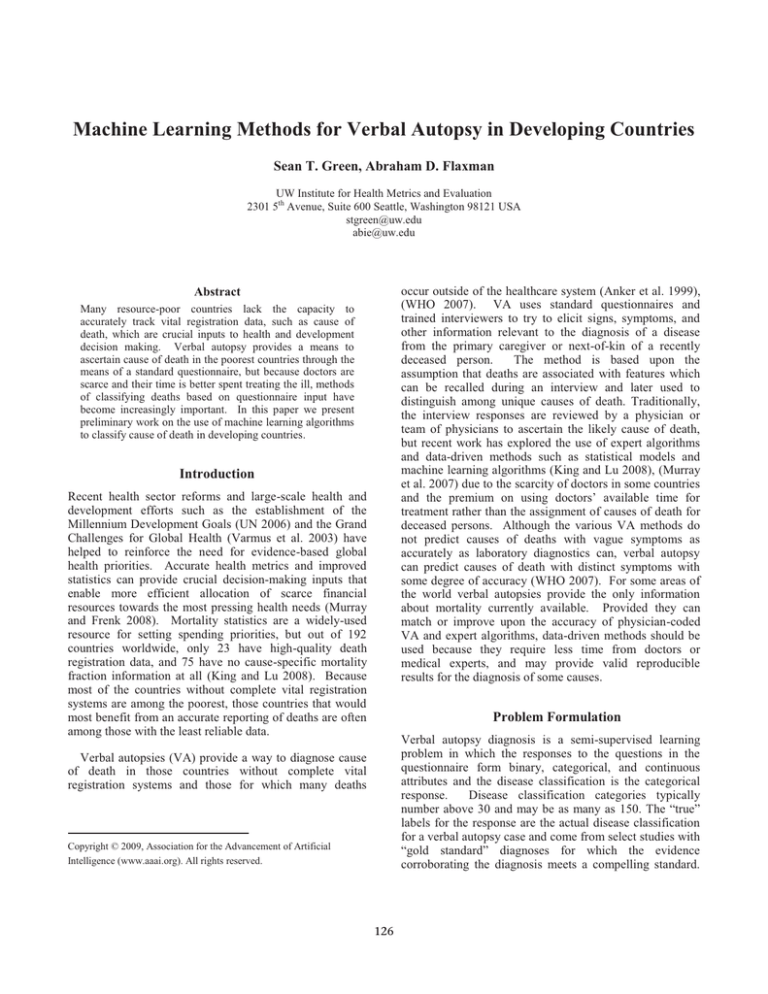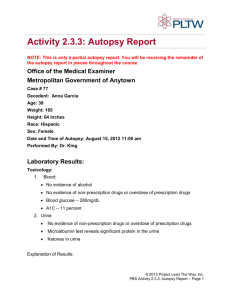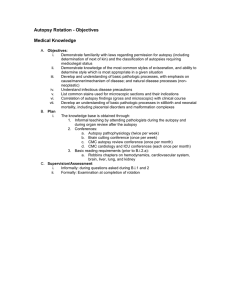
Machine Learning Methods for Verbal Autopsy in Developing Countries
Sean T. Green, Abraham D. Flaxman
UW Institute for Health Metrics and Evaluation
2301 5th Avenue, Suite 600 Seattle, Washington 98121 USA
stgreen@uw.edu
abie@uw.edu
occur outside of the healthcare system (Anker et al. 1999),
(WHO 2007). VA uses standard questionnaires and
trained interviewers to try to elicit signs, symptoms, and
other information relevant to the diagnosis of a disease
from the primary caregiver or next-of-kin of a recently
deceased person.
The method is based upon the
assumption that deaths are associated with features which
can be recalled during an interview and later used to
distinguish among unique causes of death. Traditionally,
the interview responses are reviewed by a physician or
team of physicians to ascertain the likely cause of death,
but recent work has explored the use of expert algorithms
and data-driven methods such as statistical models and
machine learning algorithms (King and Lu 2008), (Murray
et al. 2007) due to the scarcity of doctors in some countries
and the premium on using doctors’ available time for
treatment rather than the assignment of causes of death for
deceased persons. Although the various VA methods do
not predict causes of deaths with vague symptoms as
accurately as laboratory diagnostics can, verbal autopsy
can predict causes of death with distinct symptoms with
some degree of accuracy (WHO 2007). For some areas of
the world verbal autopsies provide the only information
about mortality currently available. Provided they can
match or improve upon the accuracy of physician-coded
VA and expert algorithms, data-driven methods should be
used because they require less time from doctors or
medical experts, and may provide valid reproducible
results for the diagnosis of some causes.
Abstract
Many resource-poor countries lack the capacity to
accurately track vital registration data, such as cause of
death, which are crucial inputs to health and development
decision making. Verbal autopsy provides a means to
ascertain cause of death in the poorest countries through the
means of a standard questionnaire, but because doctors are
scarce and their time is better spent treating the ill, methods
of classifying deaths based on questionnaire input have
become increasingly important. In this paper we present
preliminary work on the use of machine learning algorithms
to classify cause of death in developing countries.
Introduction1
Recent health sector reforms and large-scale health and
development efforts such as the establishment of the
Millennium Development Goals (UN 2006) and the Grand
Challenges for Global Health (Varmus et al. 2003) have
helped to reinforce the need for evidence-based global
health priorities. Accurate health metrics and improved
statistics can provide crucial decision-making inputs that
enable more efficient allocation of scarce financial
resources towards the most pressing health needs (Murray
and Frenk 2008). Mortality statistics are a widely-used
resource for setting spending priorities, but out of 192
countries worldwide, only 23 have high-quality death
registration data, and 75 have no cause-specific mortality
fraction information at all (King and Lu 2008). Because
most of the countries without complete vital registration
systems are among the poorest, those countries that would
most benefit from an accurate reporting of deaths are often
among those with the least reliable data.
Problem Formulation
Verbal autopsy diagnosis is a semi-supervised learning
problem in which the responses to the questions in the
questionnaire form binary, categorical, and continuous
attributes and the disease classification is the categorical
response.
Disease classification categories typically
number above 30 and may be as many as 150. The “true”
labels for the response are the actual disease classification
for a verbal autopsy case and come from select studies with
“gold standard” diagnoses for which the evidence
corroborating the diagnosis meets a compelling standard.
Verbal autopsies (VA) provide a way to diagnose cause
of death in those countries without complete vital
registration systems and those for which many deaths
1
Copyright © 2009, Association for the Advancement of Artificial
Intelligence (www.aaai.org). All rights reserved.
126
We are also considering other learning algorithms as well
as ways to combine the outputs of multiple models since
some models appear to predict some causes of death better
than others. The list of causes could also be adjusted, to
reduce generalization error, by clustering causes which
have similar signs and symptoms. Although individuallevel predictions provide ultimate flexibility, an
intermediate goal of predicting cause-specific mortality
fractions for age- and sex-specific subpopulations would
be sufficient for some applications.
However, because the gold standard labels often come
from studies in atypical locations within a country which
possess monitoring and data collection capacity, or from
hospital populations in a country, a question exists as to
whether the sample of cases in a data set with gold
standard diagnoses is representative of the larger
population within a country.
The goal of verbal autopsy diagnosis, to build a
classifier which is not overly attuned to the disease
fractions observed in any study, is further complicated by
the differences in disease prevalence that exist between
countries. In order for a verbal autopsy classifier to be
useful for classifying the death of an individual, it should
be able to classify a death due to a disease with a
sensitivity (true positive rate) near 90%; or in other words,
it must have a generalization error (1-specificity) less than
or equal to 10%. If the generalization error is higher, the
classifier may be useful for predicting cause specific
mortality fractions for age groups at the population level,
but does not satisfy the ideal goal of being able to predict
cause of death for individuals.
References
UN., The Millennium Development Goals Report 2006:
Statistical Annex, New York: United Nations, 2006.
H. Varmus, R. Klausner, E. Zerhouni, T. Acharya, A.S.
Daar, and P.A. Singer, “PUBLIC HEALTH: Enhanced:
Grand Challenges in Global Health,” Science, vol. 302,
2003, pp. 398-399.
C. Murray and J. Frenk, “Health metrics and evaluation:
strengthening the science,” The Lancet, vol. 371, Apr.
2008, pp. 1191-1199.
Preliminary Results
G. King and Y. Lu, “Verbal Autopsy Methods with
Multiple Causes of Death,” Statistical Science, vol. 23,
Feb. 2008, pp. 78-91.
A sample dataset from a 2001 study in Bangladesh can be
found at http://www.measureddhs.com; however, because
the data do not contain gold standard diagnoses, the true
causes of death are not known. The crude data for the 2001
Bangladesh study is typical of many VA studies. It has
928 rows, 1528 attributes (of which approximately 200
correspond to actual VA survey questions), and 140
different cause of death categories for the response. The
attributes are a mixture of demographic data and survey
response data with categorical survey responses consisting
of either a “yes/ no,” or a response category selected from
a list of 2-20 options. Continuous attributes typically
correspond to some piece of demographic information such
as household income, or the duration of disease symptoms
in days or years.
M. Anker, R. Black, C. Coldham, H. Kalter, M. Quigley,
D. Ross, and R. Snow, A standard verbal autopsy method
for investigating the cause of death in infants and children,
Geneva, Switzerland: World Health Organization, 1999.
WHO, Verbal autopsy standards: ascertaining and
attributing cause of death, Geneva, Switzerland: WHO
Press, 2007.
C.J.L. Murray, A.D. Lopez, D.M. Feehan, S.T. Peter, and
G. Yang, “Validation of the Symptom Pattern Method for
Analyzing Verbal Autopsy Data,” PLoS Med, vol. 4, Nov.
2007, p. e327.
Using an unpublished dataset with gold standard diagnoses
we are experimenting with several classification algorithms
including Support Vector Machines (Boser, Guyon, and
Vapnik 1992), Boosting with CART using the
Adaboost.M1 algorithm (Freund and Schapire 1996),
Bagging with CART (Breiman 1996), and Random Forests
(Breiman 2001). The experiments have been carried out
using the R programming environment. Thus far no
algorithm has been able to classify cause of death for all
causes with an average generalization error below 60%,
but some algorithms have been able to classify cause of
death for easy-to-identify individual causes, such as
HIV/AIDS and measles, with a generalization error below
10%. Attempts to improve classification of hard-torecognize diseases, such as cancers and other neoplasms,
usually result in increased generalization error for easy-torecognize diseases.
B.E. Boser, I.M. Guyon, and V.N. Vapnik, “A training
algorithm for optimal margin classifiers,” Proceedings of
the fifth annual workshop on Computational learning
theory, Pittsburgh, Pennsylvania, United States: ACM,
1992, pp. 144-152.
Y. Freund and R. Schapire, “Experiments with a new
boosting algorithm,” Machine Learning: Proceedings of
the 13th International Conference, Bari, Italy: Morgan
Kaufmann Publishers Inc., 1996, pp. pp.148-156.
L. Breiman, “Bagging predictors,” Machine Learning, vol.
24, 1996, pp. 123 - 140.
L. Breiman, “Random Forests,” Machine Learning, vol.
45, Oct. 2001, pp. 5-32.
127






